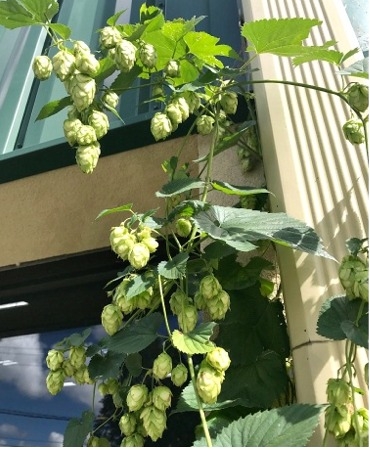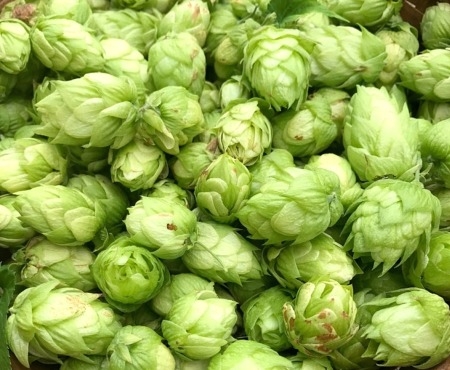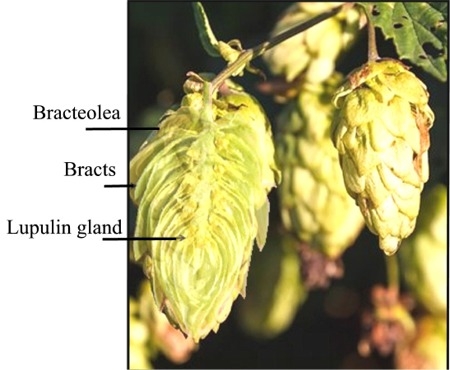 Hops are perennial vining plants that produce vines, or bines, annually from a permanent root system (crown). Bines may grow up to 30 feet in a season but will die back to the crown each fall with frost. The crown is comprised of true roots and underground running stems called rhizomes. Rhizomes possess buds and are used for vegetative propagation. Sections of rhizomes with buds will produce plants genetically identical to the original plant. Hops have separate male and female plants; only the female plants produce flowers (cones), and the cones are what are used for brewing.
Hops are perennial vining plants that produce vines, or bines, annually from a permanent root system (crown). Bines may grow up to 30 feet in a season but will die back to the crown each fall with frost. The crown is comprised of true roots and underground running stems called rhizomes. Rhizomes possess buds and are used for vegetative propagation. Sections of rhizomes with buds will produce plants genetically identical to the original plant. Hops have separate male and female plants; only the female plants produce flowers (cones), and the cones are what are used for brewing.
Where to Plant
Hop rhizomes should be planted in full sun in a permanent bed with well-draining, fertile soil with a pH range of 5.5 - 7.5, with lots of vertical space to climb. Hops can grow up to 30 feet in a single season and will require a strong support system.
When to Plant
Plant your hops rhizomes in spring once the threat of frost has passed. If you have to wait to plant, store the rhizomes in your refrigerator, in the bag that they arrived in.
How to Plant
Dig a hole about 12 inches wide, loosening the soil to about 8 to 10 inches deep, and place the rhizome, horizontally with the buds pointing upwards, 4" below the soil surface. Cover the rhizome with soil and pack it firmly by hand. Water well to settle the soil. Rhizomes should be planted at least 3 feet apart.
 Watering and Fertilizing
Watering and Fertilizing
First year hops will require frequent light watering to become established. Fertilize them regularly as you would any garden plants. Generally, hops roots need to be slightly moist, but they will rot with too much water. Mulching the soil surface above the roots helps to both add organic matter to the soil and conserve moisture.
Growing On
Hops need a very strong support system, up to 30 feet tall. Bines are easier to manage if they are trained onto strong twine. This twine can be supported by a trellis, wire, pole, tree branch or building. Keep in mind that the bines will die back to the ground each fall. At that point both the bines and twine can be cut back and composted. Early in the season, when the plants are 12 inches tall, train them by gently wrapping the bines clockwise around the twine, 2-3 bines per string and 2 strings per plant. Once trained, the bines will climb by themselves. If there are more than 6 bines per plant, prune to the strongest 3 per string.
 Harvest
Harvest
Hop cones are ready to pick when the bracteole tips (bracts at the stem end of the cone) just begin to turn papery and brown. When the hop cone is pulled apart, the lupulin glands should be yellow and sticky. If you harvest too soon, the hops won't have potency. When just a couple of the hop cones have bracteole tips just turning brown, harvest about 1/3 of the cones. Then a few days later, return again and do the same. Be sure that the cones are ripe before picking a lot of them. Check thoroughly for brown bracteole tips and sticky lupulin glands, and perhaps even taste the cones to make sure they have a good flavor. Since most cones are produced out of reach of the ground, it is safest to lower the bines to the ground to harvest the hops.
Drying
Hops can be dried for storage. Place freshly harvested cones on a screen, in a shallow layer, to dry out of the weather and wind. Fluff the cones daily so the moist inner cones are brought to the outside. If the weather is dry it could take as few as three days for the cones to dry. The hops are dry when the inner stem of the cone is brittle and breaks rather than bends. The stem takes longer to dry than the bracts, so be patient. Pack the dried cones in an airtight container and store them in the freezer until you're ready to use them.



